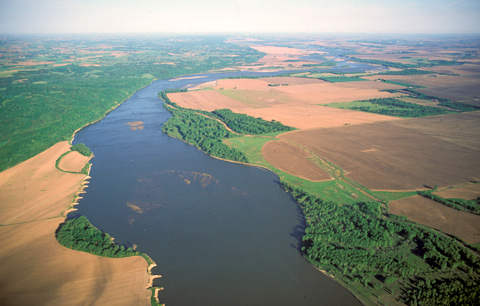Camped a few miles upstream from today’s Sioux City on 21 August 1804, Clark received a cryptic dream-name in the night—”Roloje.” The next day he applied it to a nearby stream, which is now known by its Omaha Indian name, Aowa.
The next day, as the Corps camped somewhere near the center of this photo, the captains allowed the enlisted men to express their preferences about who should replace the late Charles Floyd as sergeant, and on 26 August the commanding officers “thought it proper to appoint Patric Gass a Sergeant in the corps of volunteers for North Western Discovery.” This was the earliest written use of that name for the expedition, shortened to Corps of Discovery in Gass’s journal, published in 1807.
Here, in the vicinity of Elk Point, South Dakota (upper right), the captains found a variety of unfamiliar minerals, including what Clark believed were arsenic and cobalt. “Capt. Lewis in proveing the quality of those minerals was near poisoning himself by the fumes & taste” of the cobalt, Clark wrote, and took “a dose of salts to carry off the effects.” Two days later Lewis was still sick, not from the poison but from the medication.
Lewis had merely been poking around in a cliff of soft white limestone. The “cobalt” was just silky, lustrous selenite gypsum, and the other rocks he found were secondary minerals from interactions between calcareous chalk and iron pyrite—”fool’s gold.” They may not have pleased Lewis’s nose or palate, but they weren’t poisonous.
In the photo, the scallops in the riverbank were created by wing dams that were built by the Corps of Engineers in the 1930s and 40s to capture and settle silt, and help keep the river from changing course. Also, it was believed they would increase the river’s velocity during periods of low flow, scouring the channel and keeping it deep for barge traffic. At the turn of the 21st century studies indicated the wing dams had had the opposite effect, plus an unintended consequence of raising floodwater levels in the spring.[1]Washington University In St. Louis. “Floods Ain’t What They Used To Be; Study Shows Wing Dams Have Made Them Worse.” Science Daily, 5 December 2001. Retrieved 8 August 2008.
From Discovering Lewis & Clark from the Air
Photography by Jim Wark
Text by Joseph Mussulman
Reproduced by permission of Mountain Press
Notes
| ↑1 | Washington University In St. Louis. “Floods Ain’t What They Used To Be; Study Shows Wing Dams Have Made Them Worse.” Science Daily, 5 December 2001. Retrieved 8 August 2008. |
|---|
Experience the Lewis and Clark Trail
The Lewis and Clark Trail Experience—our sister site at lewisandclark.travel—connects the world to people and places on the Lewis and Clark Trail.
Discover More
- The Lewis and Clark Expedition: Day by Day by Gary E. Moulton (University of Nebraska Press, 2018). The story in prose, 14 May 1804–23 September 1806.
- The Lewis and Clark Journals: An American Epic of Discovery (abridged) by Gary E. Moulton (University of Nebraska Press, 2003). Selected journal excerpts, 14 May 1804–23 September 1806.
- The Lewis and Clark Journals. by Gary E. Moulton (University of Nebraska Press, 1983–2001). The complete story in 13 volumes.


